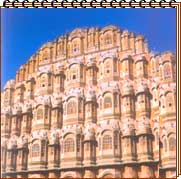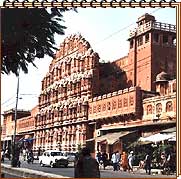Hawa Mahal - Introduction
 Jaipur is a fascinating city but to make the city fascinating, it has great palaces and other structures that are architectural wonders. Look you may from whichever way - houses, shops and havelis - they are all pink. The long crenellated walls protecting the city and the huge gateways guarding the entrance to the city are all in pink. Even the women who come to the city market from their neighboring villages are dressed in pink, gorgeous yellow, red and blue. Men dressed in white dhoti and shirts carry huge magnificent turbans - mostly pink, red and yellow. Jaipur, like the entire Rajasthan, loves color and pink more often than not. Amidst this riot of colors, the City Palace of Jaipur stands at the center. Jaipur is a fascinating city but to make the city fascinating, it has great palaces and other structures that are architectural wonders. Look you may from whichever way - houses, shops and havelis - they are all pink. The long crenellated walls protecting the city and the huge gateways guarding the entrance to the city are all in pink. Even the women who come to the city market from their neighboring villages are dressed in pink, gorgeous yellow, red and blue. Men dressed in white dhoti and shirts carry huge magnificent turbans - mostly pink, red and yellow. Jaipur, like the entire Rajasthan, loves color and pink more often than not. Amidst this riot of colors, the City Palace of Jaipur stands at the center.
This royal residence is the tallest structure in the whole complex and received additions from various maharajas till all further additions were ruled out. But even before this, within sixty years of its construction, the City Palace had to accommodate a new extension of the zenana quarters. This was the Hawa Mahal.
To the north of the city's main road intersection, the Badi Chaupad, stands Hawa Mahal - the world famous landmark of Jaipur, the best known specimen of fanciful architecture. Built in 1799 by Sawai Pratap Singh, the aesthete among maharajas, it is an integral part of the City Palace though standing away from the main complex. At first glance it looks rather whimsical in design. From the roadside, where most visitors view Hawa Mahal for the first time, it looks a mere fašade. But there is much more than meets the eye.
It is the last portion of an extensive place for the royal seraglio, a palace of winds away from the claustrophobic interiors guarded by battalions of liveried sentries. Heat, the main problem of Rajasthan cities, causes little irritation at Hawa Mahal. From the small-latticed windows, queens and princesses could watch processions on the road below without fear of being observed by the common man. It provided a concealed grandstand view.
Approached from the City Palace side, you would find yourself in a spacious courtyard guarded by a stately deorhi (door). This courtyard has a double storeyed, set of rooms on three sides. Today it houses a small museum to present a mini jharokhas of art and craft. But above these two storeys, only the eastern wing has three storeys of small intimate chambers. These apartments have only small windows for admitting light and air. This arrangement looks curious from the roadside. "Come to the window, sweet is the night air" as John Keats would have said to these charming little windows.
Views from Hawa Mahal
The upper floors are reached through a ramp rather than the regular stairs, a device to facilitate movement of palanquins carried by servants. This is a less tiresome way as the ramp ascends lazily to the top of the freestanding square tower. Imagine queens and princesses loaded with the heaviest jewelry and covered with the endless yardage of Clothes - skirts and sarees, climbing to the uppermost pavilion heaving and painting for respite from the sweltering summer heat. Here even the May-June winds feel so mild and cool. Jaipur itself appears in all its grandeur, with straight, wide roads, intersections and teeming crowds in the market.
Jantar Mantar looks a collection of mystifying masonry instruments. The City Palace stands apart, surrounded by a maze of courtyards. The Nahargarh fort, perched upon the hill, which slopes down sharply towards the palace, keeps its vigil over the city looks spectacular, a truly fairy-late setting.
Hawa Mahal - Architecture
 The fašade of the Hawa Mahal has sometimes aroused unfair judgments as 'a baroque folly' and a 'bizarre piece of architecture'. The five storeyed fašade encrusted with elegant trelliswork on windows and small balconies have 953 niches. Lal Chand Usta who designed the Hawa Mahal had dedicated it to Lord Krishna and Radha but its fanciful structure appealed to the Maharaja who found it ideal for the seraglio.
The fašade of the Hawa Mahal has sometimes aroused unfair judgments as 'a baroque folly' and a 'bizarre piece of architecture'. The five storeyed fašade encrusted with elegant trelliswork on windows and small balconies have 953 niches. Lal Chand Usta who designed the Hawa Mahal had dedicated it to Lord Krishna and Radha but its fanciful structure appealed to the Maharaja who found it ideal for the seraglio.
The pyramidal outline of the structure has one characteristic feature of architecture - symmetry, and, as in Jain temples, uses repetition of motifs to great enhancement of beauty and looks: "The forms employed are familiar enough, but the bays are crammed together, piled and multiplied so that they combine to form a larger version of themselves, in a manner strikingly reminiscent of a temple shikhara".
It has been remarked that the Hawa Mahal marks a certain decline in the architectural standards of Jaipur. This may have been the result of the increasing influence of Mughal architecture. Hawa Mahal shows a noticeable similarity with the Panch Mahal - the palace of winds at Fatehpur Sikri. Though the Panch Mahal is now a mere skeleton of columns rising in a crescendo, originally elegant jali screens between columns provided purdah (cover) from the common gaze. The Hawa Mahal follows the same principles of construction while adding to it a regular double storeyed palace in the rear of the fašade.
If it appears curious, fanciful or elaborate, it is only because of our habit of making starting comparisons. The Hawa Mahal has even been compared to a fantastic nuptial cake. Still it has an undeniable charm.
Sir Edwin Arnold like so many other admirers of Hawa Mahal paid a glowing tribute to its merits as a "vision of daring and dainty loveliness, of storeys of rosy masonry and delicate overhanging balconies and latticed windows. Soaring with tier after tier of fanciful architecture in a pyramidal form, a very mountain of airy and audacious beauty through the thousand pierced screen and gilded arches of which the Indian air blows cool over the roofs of the very highest house. Alladin's magician could have called into existence no more marvelous abode." A sumptuous of splendid architecture.
The beauty of the Hawa Mahal lies in its fragile appearance, which, like a vision, threatens of vanish into thin air. It is, of all buildings in Jaipur, the most romantic and delicate - which cannot be said of some better-known examples of solid architecture.
|


